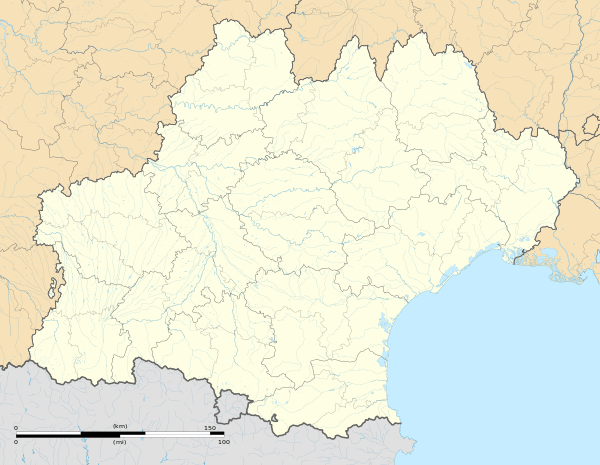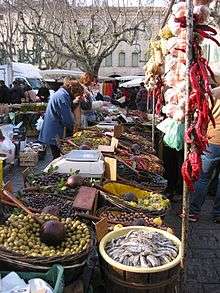Uzès
Uzès (French pronunciation: [y.zɛs], Occitan: Usès) is a small town and a commune in the Gard department in southern France.
Uzès | |
|---|---|
.jpg) View of part of the city center with Saint-Théodorit cathedral and Fenestrelle Tower. | |
 Coat of arms | |
Location of Uzès 
| |
 Uzès  Uzès | |
| Coordinates: 44°00′47″N 4°25′14″E | |
| Country | France |
| Region | Occitanie |
| Department | Gard |
| Arrondissement | Nîmes |
| Canton | Uzès |
| Intercommunality | Uzège |
| Government | |
| • Mayor (2008–2014) | Jean-Luc Chapon |
| Area 1 | 25.41 km2 (9.81 sq mi) |
| Population (2017-01-01)[1] | 8,454 |
| • Density | 330/km2 (860/sq mi) |
| Time zone | UTC+01:00 (CET) |
| • Summer (DST) | UTC+02:00 (CEST) |
| INSEE/Postal code | 30334 /30700 |
| Elevation | 49–274 m (161–899 ft) (avg. 167 m or 548 ft) |
| 1 French Land Register data, which excludes lakes, ponds, glaciers > 1 km2 (0.386 sq mi or 247 acres) and river estuaries. | |
It lies about 25 kilometres (16 miles) north-northeast of Nîmes, 40 kilometres (25 miles) west of Avignon, and 32 kilometres (20 miles) south-east of Alès.

History
Originally Ucetia or Eutica in Latin, Uzès was a small Gallo-Roman oppidum, or administrative settlement. The town lies at the source of the Alzon river, at Fontaine d'Eure, from where a Roman aqueduct was built in the first century BC, to supply water to the local city of Nîmes, 50 kilometres (31 miles) away. The most famous stretch of the aqueduct is the Pont du Gard, now a World Heritage site,[2] which carried fresh water over splendid arches across the river Gardon.
The civilized and tolerant urban life of 5th-century Uzès contrasted with the Frankish north. Jews were apparently settled there as early as the 5th century. Saint Ferréol, Bishop of Uzès, allegedly admitted them to his table; on this account complaint was made of him to King Childebert I, whereupon the bishop was obliged to change his attitude toward the Jews, compelling all those who would not become Christians to leave Uzès. After his death (581) many who had received baptism returned to Judaism.[3] Jews were expelled from the region in 614.
In early 8th century, Uzès was a fortified civitas and bishopric under the Archbishop of Narbonne. During the Umayyad conquest of Gothic Septimania, Uzès became the northernmost stronghold of Muslim Spain circa 725. Charles Martel went on to lay siege to the stronghold in 736, but it remained in Gothic-Andalusian hands up to 752, when counts loyal to Ansemund of Nîmes handed over a large number of strongholds to the Frankish Pepin the Short. In 753 the stronghold rebelled against the Franks after Ansemund's assassination, but the uprising was suppressed and a Frankish trustee of Pepin imposed.
In the 13th century, Uzès hosted a small community of Jewish scholars, as well as a community of Cathars.

Like many cloth-manufacturing centers (Uzès was known for its serges), the city and the surrounding countryside were strongly Protestant during the Wars of Religion in the 16th century, which wreaked havoc in Languedoc. Numerous of the city's churches were trashed and burned by furious Protestants: only two remain today. One such destroyed and rebuilt church is Saint-Étienne.
Dukes of Uzès
The title of Duke of Uzès, in the family de Crussol d'Uzès, is the premier title in the peerage of France, coming right after the princes of the blood. The title of seigneur d'Uzès is attested in a charter of 1088. After part of Languedoc was attached to royal demesne (1229), the lords' (and later dukes') military skill and fealty to the Crown propelled their rise through the nobility, until, after the treason of the last Duke of Montmorency, beheaded in 1632, the title of First Duke of France fell to Uzès, who retain their stronghold in the center of town today, which has expanded round the 11th century Tour Bermond. If France were a kingdom, it would be the job of the duke of Uzès to cry out, "Le Roi est mort. Vive le Roi!" at each state funeral, and defend the honour of the queen mother. Twenty-one dukes have been wounded or killed as hereditary Champion of France over the centuries.
Sights
The present-day city retains the trace of its walls as a circuit of boulevards. A Capuchin chapel, built in 1635 to house the mortal remains of the dukes, occupies the site of a 1st-century AD temple dedicated to the first Roman Emperor, Augustus. There are monuments of the prestige of the former bishopric, once one of the most extensive of Languedoc, but extinguished at the Revolution, and private houses that witness the wealth that the textile trade brought in the 16th century. The town is also homes to three feudal towers, the Bermonde Tower (part of the château du Duché), the Bishop Tower and the Royal Tower.
Uzès Cathedral was destroyed in the Albigensian Crusade, rebuilt, and destroyed again in the 16th century Wars of Religion. Rebuilt again in the 17th century, it was stripped out during the French Revolution. The 11th century Romanesque Tour Fenestrelle ("Window Tower"), with its paired windows, is probably the most famous icon of the city. It was listed as a French Historical Monument in 1862.[4]
Uzès is famous in the area for its Saturday market. Not only does the market offer local produce, but it also boasts textiles made in the region and many tourist delights.[5]
Economy
Tourism is one of the key industrial sectors, alongside the local arts scene and wine making.
The region has a long history in the production of licorice. The German company Haribo maintains a factory and museum in Uzès, which traces its roots back to the licorice factory Henri Lefont opened there in 1862. His company later merged with Ricqlès, and was then taken over by Haribo.[6]
Population
| Year | Pop. | ±% |
|---|---|---|
| 1793 | 6,150 | — |
| 1800 | 6,350 | +3.3% |
| 1806 | 6,287 | −1.0% |
| 1821 | 5,684 | −9.6% |
| 1831 | 6,162 | +8.4% |
| 1836 | 6,856 | +11.3% |
| 1841 | 7,274 | +6.1% |
| 1846 | 7,215 | −0.8% |
| 1851 | 6,934 | −3.9% |
| 1856 | 6,333 | −8.7% |
| 1861 | 6,242 | −1.4% |
| 1866 | 5,895 | −5.6% |
| 1872 | 5,574 | −5.4% |
| 1876 | 5,585 | +0.2% |
| 1881 | 5,449 | −2.4% |
| 1886 | 5,146 | −5.6% |
| 1891 | 4,989 | −3.1% |
| 1896 | 4,819 | −3.4% |
| 1901 | 4,889 | +1.5% |
| 1906 | 5,182 | +6.0% |
| 1911 | 4,804 | −7.3% |
| 1921 | 4,098 | −14.7% |
| 1926 | 4,456 | +8.7% |
| 1931 | 4,212 | −5.5% |
| 1936 | 4,033 | −4.2% |
| 1946 | 4,667 | +15.7% |
| 1954 | 5,222 | +11.9% |
| 1962 | 5,649 | +8.2% |
| 1968 | 6,851 | +21.3% |
| 1975 | 7,078 | +3.3% |
| 1982 | 7,525 | +6.3% |
| 1990 | 7,649 | +1.6% |
| 1999 | 8,007 | +4.7% |
| 2008 | 8,213 | +2.6% |
Notable people
- Firmin Abauzit (1679–1767), scholar who worked on physics, theology and philosophy
- Vice-Admiral François-Paul Brueys D'Aigalliers, Count de Brueys, (1753–1798), the French commander in the Battle of the Nile.
- Bernard Plantapilosa, later Count of Auvergne and second son of Dhuoda who was famous for her medieval literature Liber Manualis.
- David Redfern (1936–2014) English music photographer
- Suzanne Verdier (1745–1813), writer
- Oliver Bevan (2001-) English artist
See also
- Bishopric of Uzès
- Viscounts and Dukes of Uzès
- Philip O'Connor
- Communes of the Gard department
References
- "Populations légales 2017". INSEE. Retrieved 6 January 2020.
- "Pont du Gard (Roman Aqueduct)". UNESCO.
- Gallia Christiana, vi. 613; Dom Vaissète, Histoire Générale de Languedoc, i. 274, 545
- "Monument Historiques: Ancienne cathédrale Saint-Théodorit". Ministère de la culture. Retrieved 27 November 2014.
- - Delights of Uzes Market
- "Ses espaces - Le Musée du Bonbon Haribo sur Uzès dans le Gard". www.museeharibo.fr. Retrieved 2016-12-05.

Further reading
- d'Albiousse, Lionel (1881). Guide de l'étranger à Uzès (in French). Uzès: H. Malige.
- d'Albiousse, Lionel (1887). Histoire des ducs d'Uzès : suivie d'une notice sur leur château ducal (in French). Paris: H. Champion.
External links
| Wikimedia Commons has media related to Uzès. |
- Official website (in French)
- Tourist office website